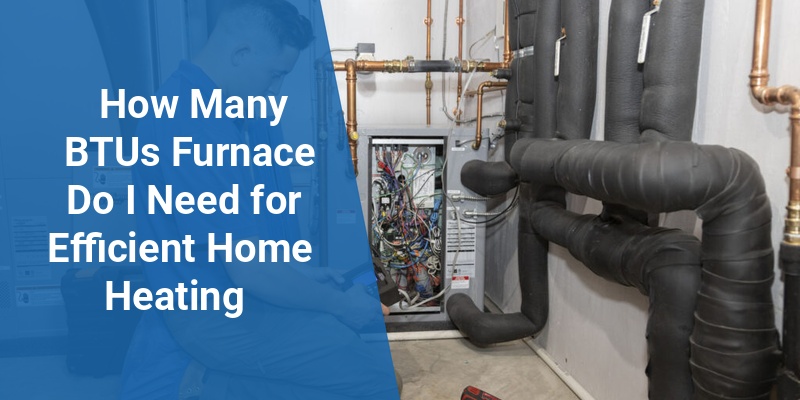Choosing the right furnace size is crucial for maintaining comfort and energy efficiency in your home. The furnace’s heating capacity is measured in BTUs (British Thermal Units), which quantifies the amount of heat the unit can produce. Selecting a furnace with the correct BTU output ensures your home stays warm without wasting energy or causing strain on the system.
| Home Size (Square Feet) | BTU Range Needed | Typical Furnace Size |
|---|---|---|
| Up to 1,000 | 30,000 – 45,000 BTUs | 40,000 BTU Furnace |
| 1,000 – 1,500 | 45,000 – 60,000 BTUs | 50,000 BTU Furnace |
| 1,500 – 2,000 | 60,000 – 80,000 BTUs | 70,000 BTU Furnace |
| 2,000+ | 80,000+ BTUs | 80,000+ BTU Furnace |
What Is BTU And Why It Matters For Furnace Selection
BTU (British Thermal Unit) is a traditional measurement of heat energy. One BTU represents the energy needed to raise the temperature of one pound of water by one degree Fahrenheit. When evaluating furnaces, BTU indicates the amount of heat a unit can generate per hour.
Choosing the correct BTU rating is essential because a furnace that is too small will struggle to heat your home, increasing wear and tear and energy costs. Conversely, an oversized furnace will cycle on and off frequently, causing inefficiency, higher utility bills, and discomfort.
Factors Influencing The BTU Furnace Size You Need
Several variables determine how many BTUs your furnace must produce to heat your home efficiently. These include:
- Home Size: Larger spaces naturally require more BTUs to maintain comfortable temperatures.
- Climate Zone: Colder climates demand furnaces with higher BTU capacities.
- Insulation Quality: Well-insulated homes retain heat better, reducing BTU requirements.
- Windows and Doors: The number, type, and quality of windows and doors affect heat loss.
- Ceiling Height: Higher ceilings increase the volume of air needing heating, thus more BTUs.
- Air Leakage: Drafts and leaks can drive up heating needs.
Calculating The Right Furnace Size Using BTU Per Square Foot
A common rule of thumb is using BTU per square foot as a starting point for furnace sizing. This method estimates the heat required based on your home’s square footage.
| Climate Zone | Approximate BTU Per Sq Ft |
|---|---|
| Mild Climate (South) | 25 – 30 BTUs |
| Moderate Climate (Midwest) | 30 – 40 BTUs |
| Cold Climate (North) | 40 – 50 BTUs |
Example: In a cold climate, a 1,500 sq ft house might require 60,000 to 75,000 BTUs (calculated as 40-50 BTUs x 1,500 sq ft).
Using Manual J Calculation For Accurate Furnace Sizing
The most reliable method to determine furnace size is the Manual J calculation. This detailed assessment performed by HVAC professionals takes into account:
Call 888-906-9139 for Free Local HVAC Quotes – No Obligation, Just Savings!
- Home size and layout
- Insulation levels
- Window types and orientation
- Air infiltration rates
- Local climate conditions
This analysis provides a precise BTU requirement tailored to the specific characteristics of your home, ensuring comfort and optimal furnace performance.
Additional Considerations When Choosing Furnace BTU Capacity
- Efficiency Ratings: High-efficiency furnaces may provide similar heat output at lower BTUs due to better heat transfer and less waste.
- Furnace Type: Gas, electric, or propane furnaces may affect BTU needs and operating costs differently.
- Future Home Changes: Anticipate any additions or upgrades that may affect heating needs.
- Zoning Systems: Homes with multiple heating zones might require separate calculations for each area.
Common Mistakes To Avoid When Selecting Furnace Size
Oversizing the furnace leads to short cycling, decreased efficiency, and increased wear. Undersized furnaces cause the system to run continuously, unable to maintain comfortable temperatures.
Many homeowners attempt to base furnace size solely on square footage without considering insulation or climate, which results in inaccurate sizing. Professional assessments using standards like Manual J are recommended for best results.
How To Upgrade Or Replace Your Furnace
When upgrading your existing furnace, consider the following steps:
- Consult a licensed HVAC professional for a Manual J heat load calculation
- Compare furnace efficiency ratings (AFUE)
- Assess your current home’s insulation and air sealing
- Determine your budget and energy goals
- Review available furnace sizes with suitable BTUs for your home
Proper furnace sizing ensures lower utility bills, extends equipment life, and keeps your home consistently warm during the winter.
